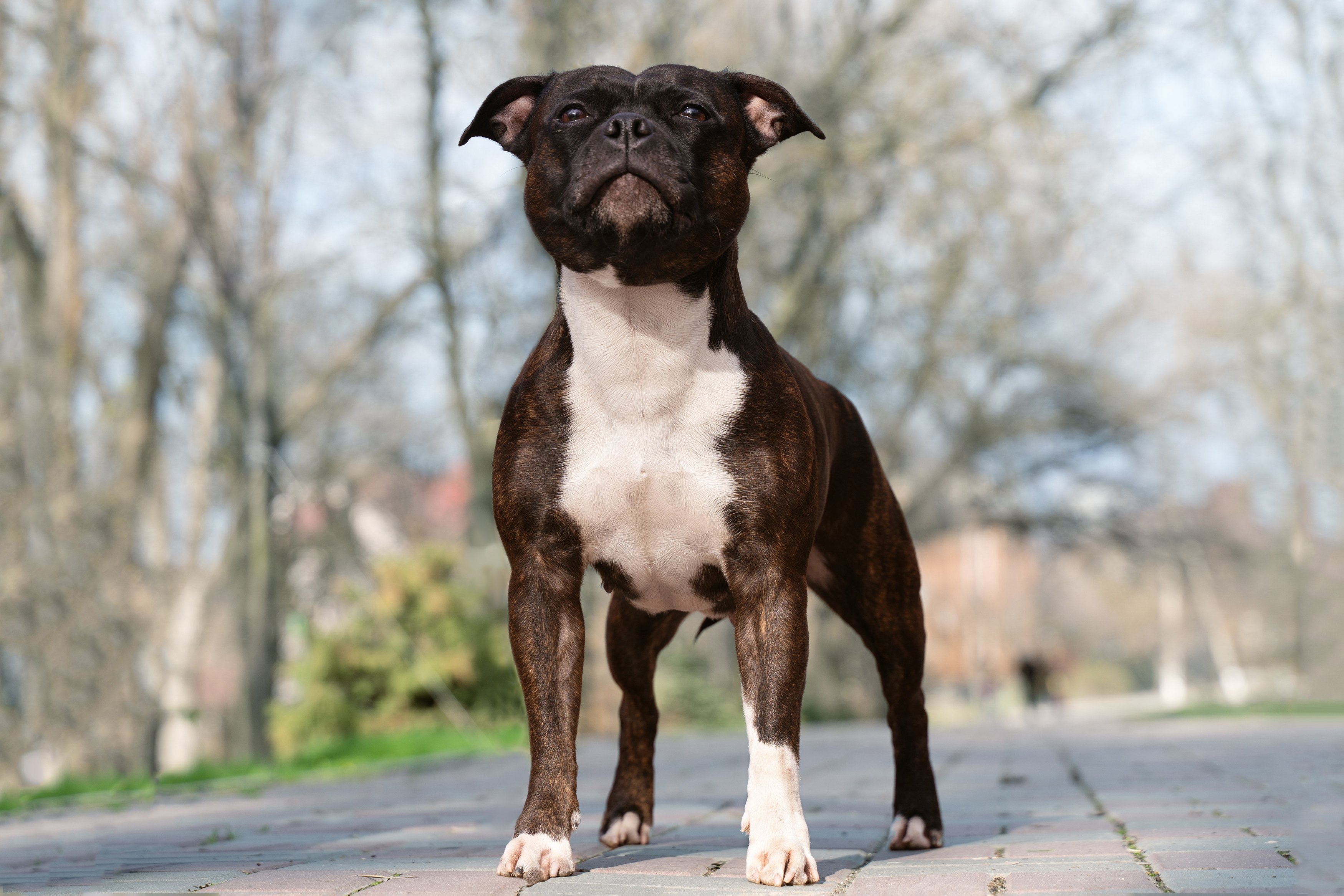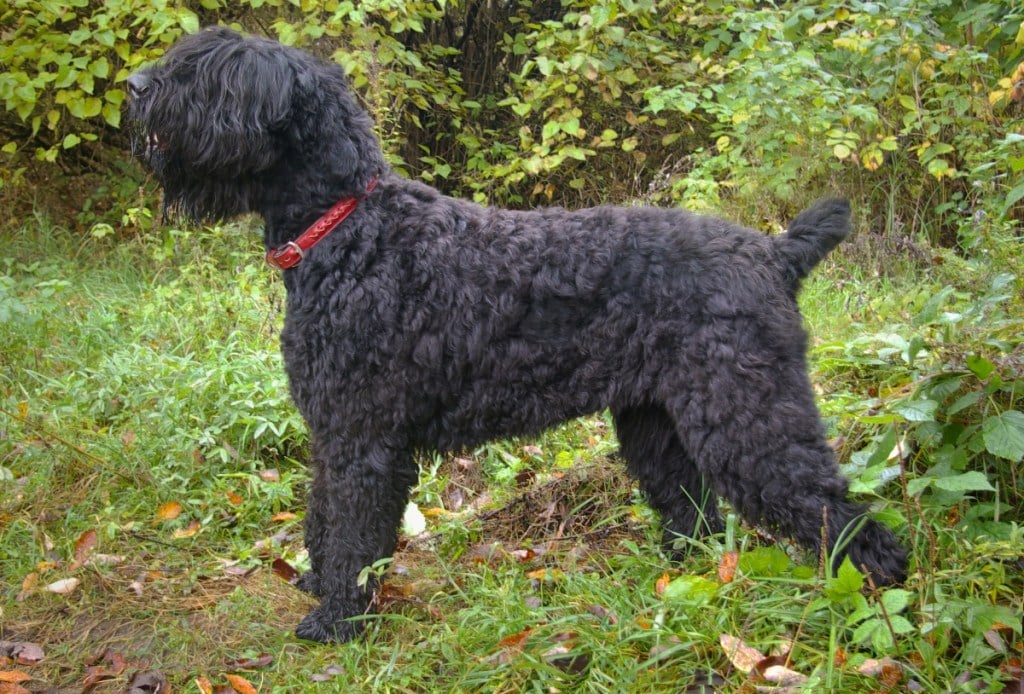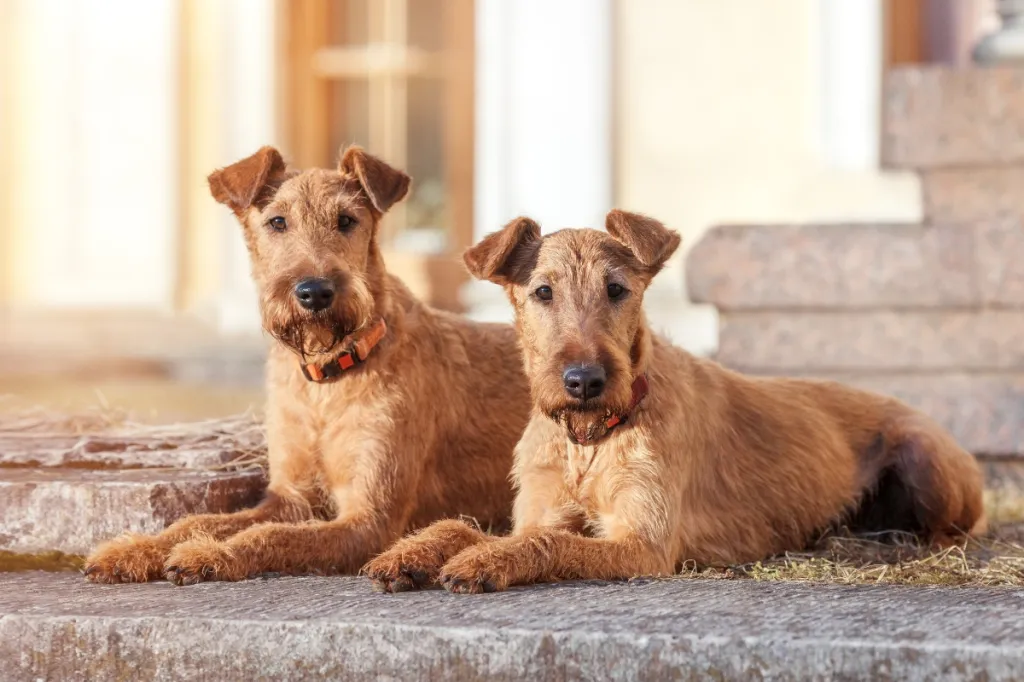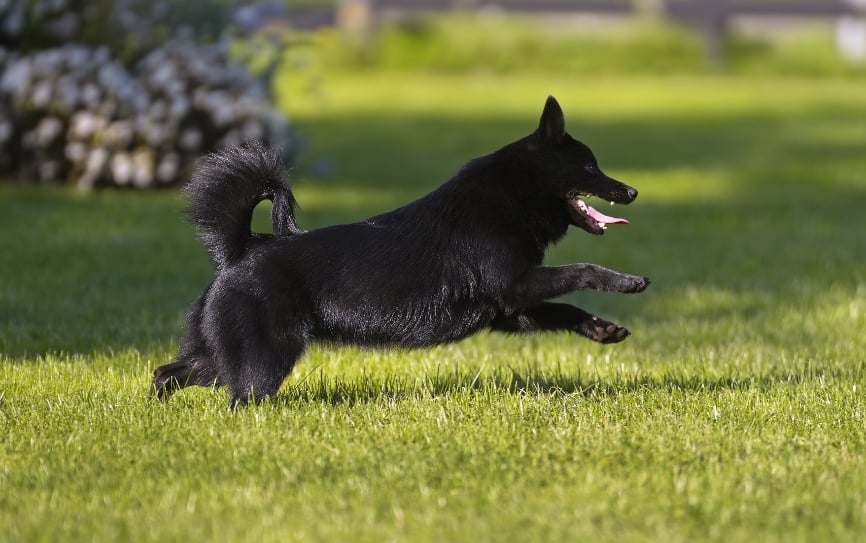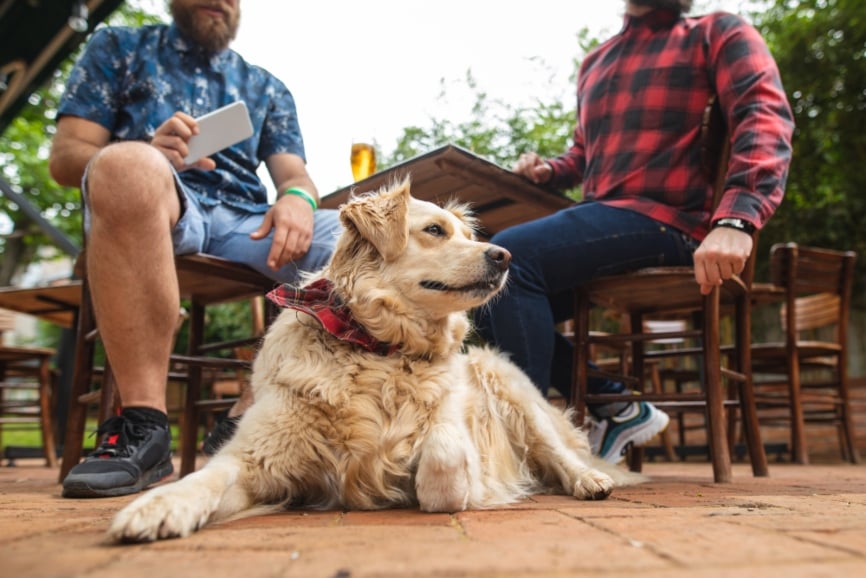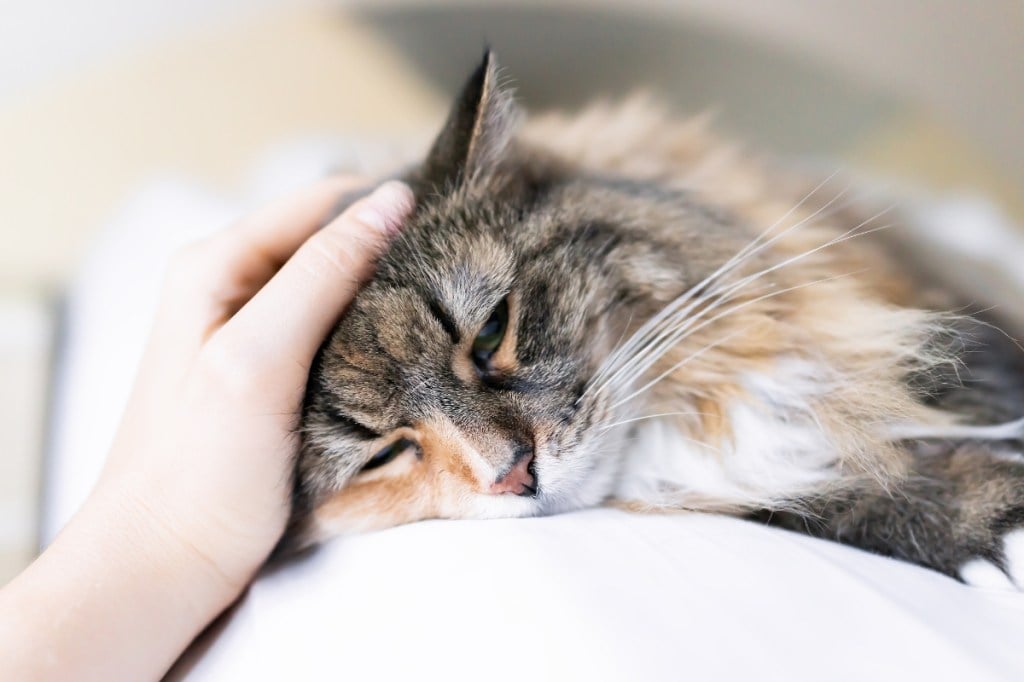Introduction to Staffordshire Bull Terriers
Staffordshire bull terriers are Terrier Group dogs of medium size known for being brave and clever. Yes, they have a somewhat troubled dog-fighting history. But as long as they are raised well, modern dogs of this breed are designed to be lovers, not fighters. Staffordshire bull terriers are strong, muscular, agile, and love kids. Their rock-solid build once brought success in European dog fighting pits. Yet modern Staffies are sweet-natured, eager to please, and wonderful family companions when adequately socialized.
Whether you’re looking for a purebred Staffordshire bull terrier, an adoptable dog, or a mixed breed with Staffie roots, here are some essential things to know about this dog breed.
Size of Staffordshire Bull Terriers
An adult male Staffordshire bull terrier weighs 28 to 38 pounds, and the female weighs 24 to 34 pounds. These dogs stand 14 to 16 inches tall when fully grown. They are considered to be fully grown between the ages of 12 and 18 months; however, many Staffies will get bulkier until they are two or three years old.
Here’s how big you can expect your Staffordshire bull terrier to get as the dog grows from puppyhood to adulthood. Female dogs weigh in on the low end of these ranges, and average males are at the high end of the weight ranges.
| Weight Chart | 3 months | 6 months | 9 months | 12 months |
| Male and female Staffordshire bull terriers | 8 – 15 lbs. | 16 – 27 lbs. | 20 – 34 lbs. | 22 – 37 lbs. |
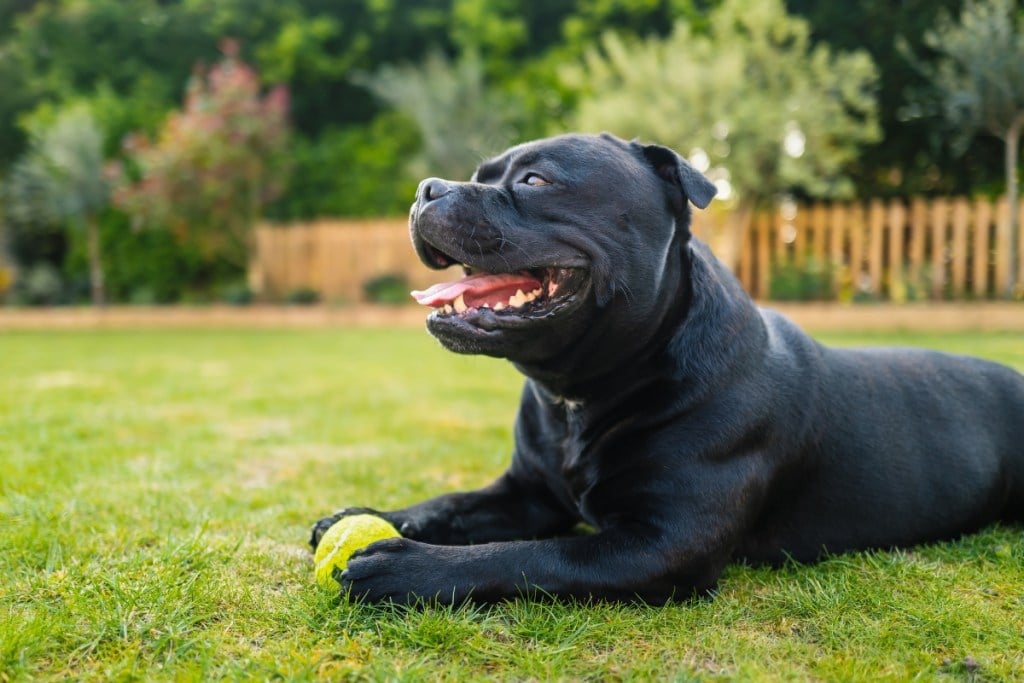
Characteristics of Staffordshire Bull Terriers
Staffordshire bull terriers are not particularly tall dogs but have a lot of muscle to them. They have short and broad heads, and their coats come in various colors. They still somewhat look like the brawling dogs of the past but have very different temperaments and can learn good manners with consistency and patience.
Staffies are generally best for experienced pet parents who can commit to ongoing training and show them the love they need every day. They often do best in households where they are the only pets because unless they have been extremely well-socialized, they may become aggressive around other dogs and can have a strong prey drive. On the other hand, they tend to be wonderful with children, but as is the case with all dogs, should never be left unsupervised around kids.
As you get to know a Staffordshire bull terrier’s personality, here’s what you can expect based on his or her breed characteristics:
| Breed Characteristic | Level (High, Medium, Low) |
| Affectionate with People | High |
| Good with Kids | High |
| Good with Pets | Low |
| Need for Exercise | High |
| Energy Level | Medium |
| Intelligence Level | Medium |
| Able to Be Trained | Medium |
| Amount of Barking | Medium |
| Amount of Shedding | Medium |
History of Staffordshire Bull Terriers
Staffordshire bull terriers are a relatively newer dog breed, based on world history. A bulldog crossed with a terrier was the origin of the Staffordshire bull terrier. Dog-oriented blood sports were part of the standard culture in England for many years, gruesome sports in which gamblers bet big money to see which dog would win in fighting rings. These types of blood sports were made illegal in 1835 but continued underground and out of the eyes of the law. The perfection of the Staffordshire bull terrier breed is credited to James Hinks of Birmingham, England, and the dog’s name is a reference to Staffordshire county in England, where the breed became very popular.
The breed arrived in North America in the 1880s. In the U.S., breeders developed a new breed to be slightly heavier and taller, which was eventually called the American Staffordshire Terrier. The American Kennel Club recognized the Staffordshire Bull Terrier in 1974.
Staffordshire Bull Terrier Standard Information
Here is an overview of the breed standard information for Staffordshire bull terriers:
Head:
- Short, deep through, and broad skull
- Pronounced cheek muscles
- Dark eyes preferable, round and of medium size
- Rose or half-pricked ears that are not large
- Lips are tight and clean
Neck, Topline, Body:
- Muscular, short, and gradually widening neck
- Close-coupled body with a level topline
- Undocked tail of medium length and set low
Forequarters:
- Straight and well-boned legs
- Dewclaws may be removed
- Feet are well padded, medium size, and strong
Hindquarters:
- Well-muscled and hocks let down with stifles well-bent
- Dewclaws are generally removed
Coat:
- Short, smooth, and close to the skin
- Should not be trimmed or de-whiskered
Color:
- White, black, blue, red, or fawn, and any of these colors mixed with white
- Any shade of brindle or brindle with white
- Black and tan or liver colors are not acceptable
Gait:
- Free, agile, and powerful
- Legs move parallel when viewed from the front or rear
- Discernable drive from hind legs
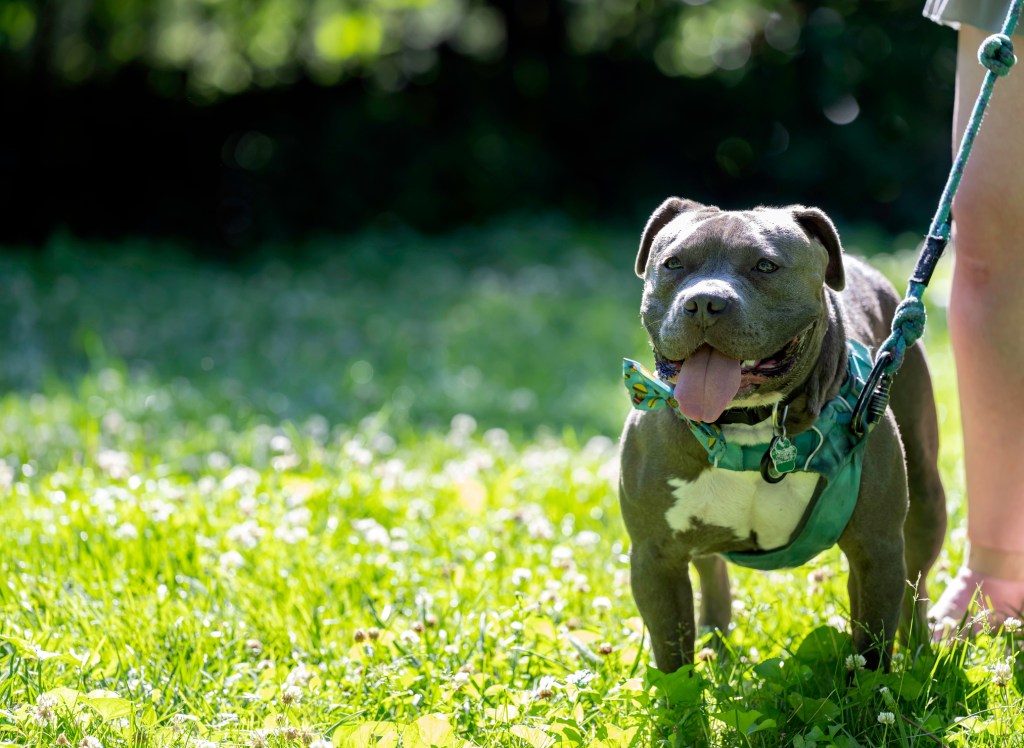
Caring for Staffordshire Bull Terriers
Staffordshire bull terriers are among the easiest dog breeds to groom. They only require weekly brushing and occasional baths. These dogs require frequent exercise to stay physically fit and mentally stimulated. However, the exercise a Staffie needs is a lot of fun – think hiking through the woods, jogging around the neighborhood, and games of fetch in the backyard.
They do not do well in extreme heat or humidity, so you’ll need to monitor your dog’s activity during the summer. These are not dogs to be left outside to fend for themselves but rather intelligent canines that thrive on daily play sessions, brisk walks on a leash, and cuddle time with family members.
Here are some general tips for taking the best care of a Staffordshire bull terrier:
Best Living Environments:
- Homes with yards are generally better than apartments
- However, apartments can work if you prioritize walks and outside play time
- Not very tolerant of hot weather
- Not tolerant of being left alone all day
Type of Exercise:
- Hiking in the woods
- Running alongside a pet parent on foot
- Limit excessive exercise during hot weather
- Not great swimmers, so monitor them around water
Mental Enrichment:
- Games of fetch in a yard
- Daily play sessions with loved ones
- Lots of safe chew toys
Training Strategies:
- Intelligent dogs that respond quickly to training
- Eager to please pet parents
- Training is required to control temperament traits
- Work to overcome the strong prey drive
- Practice leash training to prevent pulling
- Housetraining is generally easy
Grooming Tips:
- Brush weekly with a hound glove or horsehair mitt
- Trim nails as needed
- Clean ears as needed to remove wax and debris
- Brush teeth daily
Common Health Problems of Staffordshire Bull Terriers
The life expectancy of a Staffordshire bull terrier is 12 to 14 years. Because of how these dogs have been bred over the years, the national breed club recommends the following health tests for breeding animals: ophthalmologist evaluation, L-2 hydroxyglutaric aciduria DNA test, hereditary cataracts DNA test, and screenings for hip dysplasia and elbow dysplasia. An evaluation for patellar luxation and a congenital cardiac database are recommended but not required.
Staffies are generally healthy dogs, but many health issues don’t appear until later in life. Some of the health issues that may arise with Staffordshire bull terriers include:
- Hip dysplasia
- Elbow dysplasia
- Patellar luxation
- Hereditary juvenile cataracts
- L-2 hydroxyglutaric aciduria
- Skin allergies
- Demodectic mange
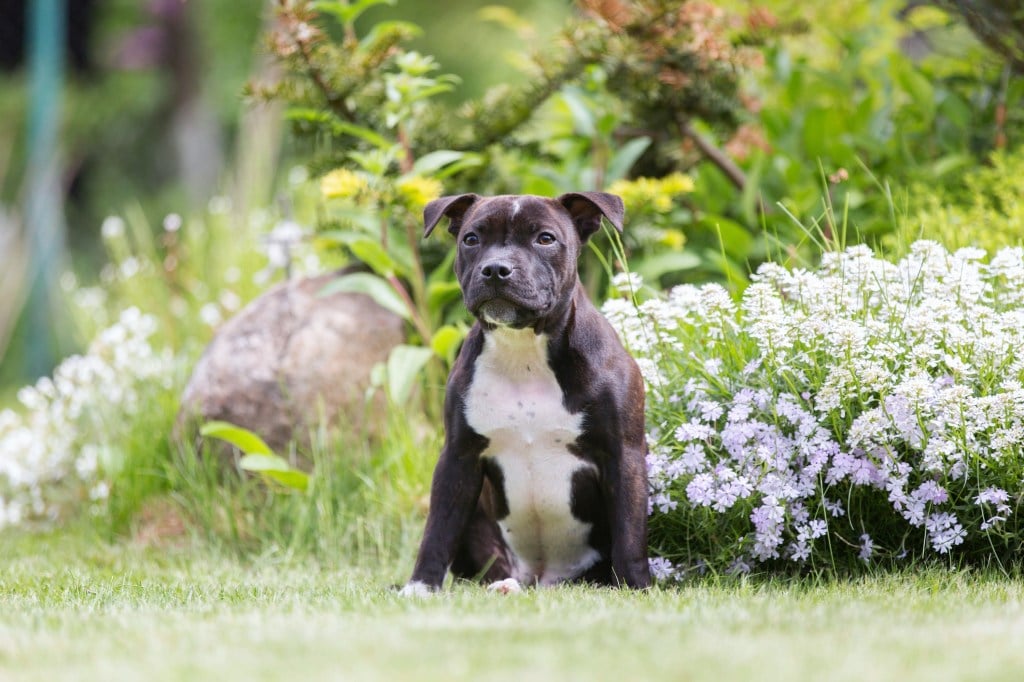
Diet and Nutrition for Staffordshire Bull Terriers
Most adult Staffordshire bull terriers will thrive when eating a high-quality, nutritionally complete and balanced adult dog food. Puppies should eat puppy food until they are around 12 months old. If you feed your Staffie homemade dog food, make sure you are working from a recipe that is designed by a veterinary nutritionist and that is appropriate for your dog’s age and health status. Some recommended food brands for your Staffordshire bull terrier include Blue Buffalo Wilderness Grain-Free, Ziwi Peak Air-Dried, Advance Adult Terriers Ocean Fish, and Open Farm White Fish. Due to common skin allergies and conditions, some pet parents of Staffies choose diets rich in omega-3 fatty acids to soothe and nourish the skin.
Feed the amount of dog food needed to keep your pet slim. You should be able to see your Staffordshire bull terrier’s waist and feel (but not see) their ribs without having to press too hard. Divide the total amount of food for the day into at least two meals for adults and three to five meals for puppies.
Limit the number of treats you give to help keep your dog’s weight under control. Although treats can be useful during training sessions, limit high-calorie treats and use training treats sparingly when working with a Staffie.
Good nutrition is very important for Staffordshire bull terriers to live long and happy lives. Talk to your veterinarian if you have any questions about your dog’s diet or health.
Where to Adopt or Purchase Staffordshire Bull Terriers
If you want to bring a Staffordshire bull terrier into your life, one resource to consider is the Staffordshire Bull Terrier Club of America. This club provides links to a breeder directory, which you can search by state and contact breeders directly to inquire about available puppies. There is also the Staffordshire Bull Terrier Club of America Rescue, which helps homeless pets and pets in shelters find loving homes. It is also common to find Staffies and Staffie mixes in local animal shelters and foster care situations, just waiting for you to discover and meet them.
Related Breeds
There are many other dog breeds that share similar physical and behavioral characteristics with the Staffordshire bull terrier. Consider learning more about these breeds before you settle on a Staffordshire bull terrier as your next pet:
- American Staffordshire terrier
- Bull terrier
- American pit bull terrier
- Bulldog
- Boxer
- Cane corso
- Dogo Argentino
Pet Insurance for Staffordshire Bull Terriers
Something else to consider is investing in pet health insurance to help your Staffordshire bull terrier live a long and healthy life. Healthy Paws offers Staffordshire bull terrier insurance that covers accidents, illnesses, emergency care, cancer, hereditary conditions, breed-specific conditions, and alternative care. Whenever your Staffie isn’t feeling well, you can take your pup to any licensed vet you trust and submit the bills to us through our website or mobile app.
Request your Staffordshire bull terrier insurance quote today and have peace of mind that you can afford the necessary treatment your dog needs, from puppyhood to all the way to senior dog status.
